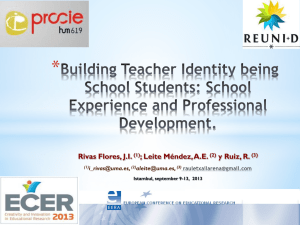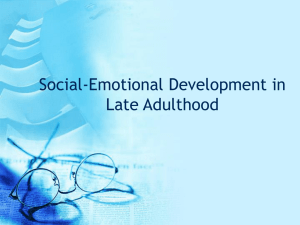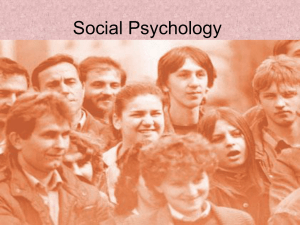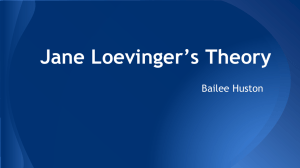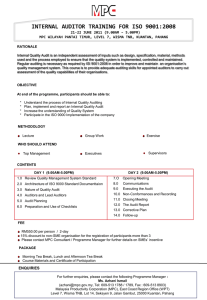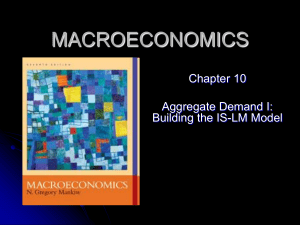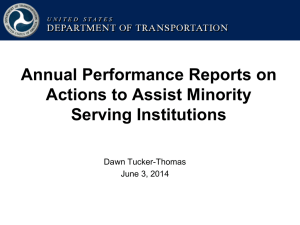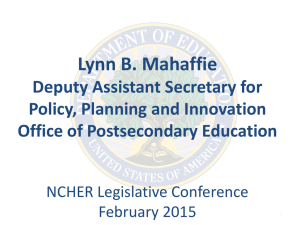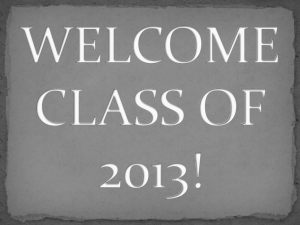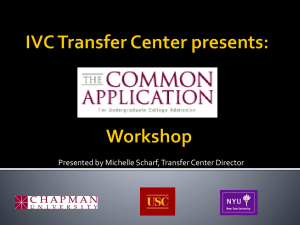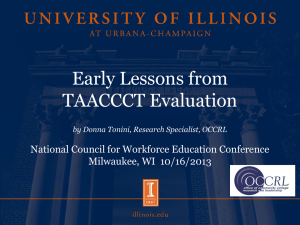Tom Brown`s breakout presentation
advertisement
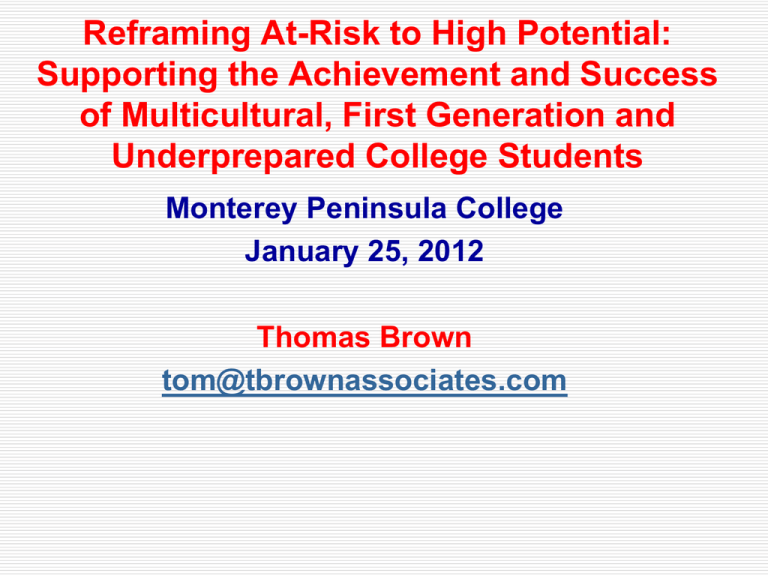
Reframing At-Risk to High Potential: Supporting the Achievement and Success of Multicultural, First Generation and Underprepared College Students Monterey Peninsula College January 25, 2012 Thomas Brown tom@tbrownassociates.com A good workshop provides information with which you agree. A better one offers information you can use. Knowledge is not power…. Saber Entender Sentir Escoger y Hacer! ThinkingFeelingDOING! Fulfilling the Promise of the Community College Co-editors Thomas Brown Margaret C. King Patricia Stanley Co-sponsored by 4 Today’s session Examine challenges and successes in increasing persistence of multicultural, first generation, and underprepared community college students Discuss barriers to students success Share effective theoretically based practices— individual and institutional Solve the Mideast crisis! The American formula for success consists of five pillars: The first pillar is providing public education for more Americans. That Used to Be Us Tom Friedman &Michael Mandelbaum, 2011 Community colleges have gone from being the stepchild to being the golden child… Dr. Frank Chong, Deputy Assistant Secretary for Community Colleges, 2011 The Challenge Community colleges have a more complicated and more difficult retention pathway because they are likely to attract students who are less-college ready than those who attend the four-year sector…. Linda Serra Hagedorn, President Iowa Association for the Study of Higher Education, 2010 Some at-risk groups in education First-generation/Low SES students Adult and re-entry students Student with disabilities Student-Athletes First-year students Undecided students LGBTQ students Students of Color Underprepared students Veterans Transfer students Multiple issues… First-generation/Low SES AND ALSO… Adult and re-entry students Student with disabilities Student-Athletes First-year students Undecided students LGBTQ students Students of Color Underprepared students Veterans Transfer students Treating students the same may be equal treatment, Treating students the same may be equal treatment, but it is not equitable treatment. Human beings seek to economize on the energy required to make distinctions. Most houseplants die because we treat them all the same. Context for this session… Forty percent of new students are the first in their families to attend college. (National Center for Education Statistics, 1996, 1998, 2001) Often, they are not as academically or socially prepared as others and are prone to drop out. Watson Scott Swail, President Educational Policy Institute Chronicle of Higher Education, 1/19/04 Context for this session… The majority of community college students are academically underprepared to achieve success. Schuetz & Bailey, 2008 Some Americans Are Much Less Likely to Graduate From College: Bachelor’s degree earned by age 24 Young People From High SES Families 75% Young People From Low SES Families 9% SES is a weighted variable developed by NCES, which includes parental education levels and occupations and family income. “High” and “low” refer to the highest and lowest quartiles of SES. Source: “Family Income and Higher Education Opportunity 1970 to 2003,” in Postsecondary Education Opportunity, Number 156, June 2005. Context for this session… National Graduation Rates Community Colleges 28% MPC Graduation & Transfer Rates* 50% (2007 Entering cohort) *National Center for Education Statistics (NCES) MPC Graduation & Transfer Rates White Hispanic/Latino Asian/Pacific Islander Black 27% 25 21 11 Source: NCES Context for this session… MPC Strategic Goals & Objectives, 2010-14 Goal 1: Promote academic excellence and student success Goal 2: Promote diversity throughout the institution Engagement Matters The more contact students have with their teachers [and peers], the more likely they are to learn effectively and persist toward achievement of their educational goals. Through such interactions, faculty members become role models, mentors, and guides for continuous, lifelong learning. Community College Survey of Student Engagement (CCSSE) Engagement Matters… When community college students described occasions when they considered dropping out and didn’t, they typically referred to a strong early connection to someone at the college. Very often, they even offered a person’s name… McClenney, 2011 Colleges are more likely to blame student attrition on students…. What Works in Student Retention, 2004, 2010 We build beautiful campuses, We hire excellent faculty and staff, We develop a challenging curriculum… then the “wrong” students show up! What happens to students after they enroll frequently has a more powerful impact on whether they stay and achieve their goals or leave. Leaving College Vincent Tinto 1987, 1993 Community colleges care less about who we enroll and more about what happens to students as a result of their having been with us…. Dr. Patricia Stanley Past Deputy Assistant Secretary for Community Colleges January 4, 2010 While students must accept responsibility for their own success or failure, institutional actors, particularly faculty members, also bear individual and collective responsibility for student outcomes. Achieving Equitable Outcome for All Students AAC&U, 2005 Why do students leave college? Isolation Inability to connect with significant members of the campus community… Attributes/calidades of an environment that supports students who are at-risk: Intentional Structured Proactive Increasing engagement and persistence Student success is not an accident – it is the result of intentional activities taken by individuals and institutions. A Model for Ensuring Student Success Changing Environment & Changing Students 1st Year 2nd Year 3rd Year and beyond Need for Information Changing Needs Creamer, 2000; Need for Consultation Changing Environment & Changing Students 1st Year 2nd Year 3rd Year and beyond Need for Information Changing Needs Moving In PRESCRIPTIVE Need for Consultation Moving Through Moving On DEVELOPMENTAL Lynch, 1989; Brown& Rivas, 1994; Creamer, 2000 Changing Environment & Changing Students 1st Year 2nd Year 3rd Year and beyond Need for Information Changing Needs Need for Consultation Moving In MPC Moving Through MPC/S MPC/S Moving On S/MPC S MPC = Faculty, counselors, academic advisors, etc. S = Student PRESCRIPTIVE DEVELOPMENTAL Lynch, 1989; Brown& Rivas, 1994; Creamer, 2000; Brown, 2006 Students usually have a realistic understanding about the demands of academic work and what is required to be successful in their classes. (n = 1587) Strongly agree/agree 13% Disagree/strongly disagree 69% Brown Survey of Faculty Do students understand what is required to be successful in college? I am rolling on the floor!!! Brown Survey How much time do community college students spend preparing for class? 21 or more hours per week 12% 10 hours or less 66% CCSSE, 2007 I have to teach students how to study before I can get to course content… Faculty Member Odessa Community College Chapter 4: Reframing At-Risk to High Potential: Supporting the Achievement and Success of Underprepared Students Thomas Brown, Managing Principal Thomas Brown & Associates, LLC Dr. Mario Rivas, Professor of Psychology Merritt College There are within each of us the seeds of who we might become. Thich Nhat Hanh The task of the excellent teacher is to stimulate "apparently ordinary" people to unusual effort. The tough problem is not identifying winners: it is in making winners out of ordinary people. K. Patricia Cross, Professor of Higher Education Emerita University of California, Berkeley Community colleges are on the frontlines of US higher education, providing opportunities to countless Americans who would otherwise be denied access…. Dr. Mario Rivas & Tom Brown New Directions for Community Colleges, 1993 Community colleges make winners out of ordinary people. Leslie Koltai, 1993 The mission of the community college presupposes that in order for students to succeed, they must be engaged with educators who believe in the capacity of all students to develop and learn! Rivas and Brown, 2011 While faculty and staff may be committed to student success, most institutions have a fragmented approach to responding to student needs. Sperling, 2009 They are more likely to blame student attrition on students! Professional development is critical to faculty and student success Today’s teachers have more pressure on them than ever before. They need the most comprehensive and relevant training available to enhance their own skills and their students’ abilities Dr. Richard Malena, Director of Education Mesa Community College From a psychological perspective, under-preparedness may stem from low-self efficacy, or the sense that one has little control over thoughts, feeling, and actions conducive to success. Bandura, 1985 Educators need to create trusting relationships with students. Vasti Torres, et al., 2006 Stereotype Threat Arises when students are in situations where their performance could result in their being reduced to a stereotype, where they could be judged by a stereotype, or where judgments about them could be made based on a stereotype. Professor Claude M. Steele Stanford University, 1995 Stereotype Threat Black students can be reticent in the classroom because if they make a mistake, it can be taken as a stereotype and confirm their being academically inferior. Steele 2010 Example: Lupe’s reason for not speaking up in class even when she feels that she knows answer and wants to speak. “If I answer wrong, they’ll all laugh at me…and think I’m stupid.” “Soy estupida!” “ I start getting nervous because all the eyes are on me!” Stereotype threat has also emerged as a possible cause of the inequalities women face upon entering majors and careers dominated by men, such as science, math and engineering Steele, James, & Barnett, 2002 Schools can eliminate some of the stereotype tension by building trust between teachers and students and protecting student identities and confidence in the classroom. see: http://reducingstereotypethreat.org Many non-traditional students want their doubts [dudas] erased about their being capable of learning…. This is especially true for first generation students, Hispanic and African American students…. Laura Rendon Transforming Students Through Validation Success appears to be contingent on whether [faculty and staff] can validate students in an academic or interpersonal way. Laura Rendon, 1994, 2001 Optimism is a better predictor of first-year college grades than SAT scores or high school grades. Martin Seligman University of Pennsylvania OPTIMISM… Having a strong expectation that things will turn out all right, despite setbacks and frustrations. Optimism can be learned. I scored 700 on my SATs and I have a Ph.D. in Biology from the University of California…. Dr. Robert Urtecho College of the Sequoias (CA) Cognitive, Emotional, and Behavioral Barriers to Student Success Low ability attributions Ego vs. Task involvement Reluctance to seek assistance Cognitive, Emotional, and Behavioral Barriers to Student Success Low ability attributions Ego vs. Task involvement Reluctance to seek assistance Attributions 1. 2. Explain reasons for successes or failures, Influence expectations, future efforts, persistence on educational tasks, etc.. Brown & Rivas, 1997, 2004, 2011 Attributions are beliefs 1. 2. Explain reasons for successes or failures, Influence expectations, future efforts, persistence on educational tasks, etc.. Brown & Rivas, 1997, 2004, 2011 Ability Attributions… By the time students reach high school, they generally believe that ability is a relatively fixed, unchangeable capacity. British Journal of Developmental Psychology, 1983 Ability Attributions… By the time students reach high school, they generally believe ability is a relatively fixed, unchangeable capacity. British Journal of Developmental Psychology, 1983 Undermining Attributions Negative thoughts about ability & task difficulty that can inhibit students’ “direction, strength, and persistence of behavior toward a goal.” Attribution Theory of Achievement and Emotion Ability Perception Feeling Low Shame & Doubt Task-Difficulty Goal Expectancy High Helpless Hopeless Low Give up (Drop out) Weiner, 1972 & 1977 “I am not smart and don’t belong in college!” “No soy inteligente.” “Soy bruta! The Power of Emotions Emotions have a powerful effect on the student achievement behaviors: “ Siempre estoy nervioso/a en clase y no quiero participar!” “ I’m always nervous in class and I don’t want to participate!” Latina community college student African American men report being stereotyped based on the styles they wear, such as baggy jeans, braided hairstyles, or gold jewelry. Terms of Engagement: Men of Color Discuss Their Experiences in Community College. MDRC, 2010 But they did not allow these negative attitudes and racial stereotypes to hinder their pursuit of higher education and career goals. MDRC, 2010 A critical element in increasing student success: Help examine and challenge low ability and high task-difficulty attributions (beliefs)—ours and theirs. “I can’t do Calculus….” “Those students can’t do Calculus….” Is there “Math DNA?” A “Calculus gene?” What Background is required for success in Calculus Pre-Calculus Algebra/Trig Algebra Basic Math What Background is required for success in Reading Writing Accounting Biology, Chemistry, etc. Other developmental or Gateway courses Shift attributions (beliefs) from ability to background preparedness. Students’ attributions and those of faculty and staff. It’s not enough to change what we do, we must also change what we believe. The fixed mindset limits achievement It makes effort disagreeable Leads to inferior learning strategies Makes other people into judges instead of allies. Carol Dweck, 2008 Cognitive, Emotional, and Behavioral Barriers to Student Success Low ability attributions Ego vs. Task involvement Reluctance to seek assistance Task versus Ego-Involvement Ego involvement- negative emotions occur and undermine achievement because students are focused on comparing themselves to others rather than task of developing competence. Compare and despair…. The Challenge SHIFT students from Ego-Involvement to Task-Involvement… Rivas 0-100% Competence Method 100 Break the Task Into Do-able Components 0 Task versus Ego Involvement 100 100 95 Ideal others 40 Shame, despair, anger frustration, fear, etc. 0 0 Ego Involvement (Focus on Comparison to Others) “Compare and Despair” Task versus Ego Involvement 100 100 95 Ideal others 80 40 0 Task Involvement (Focus on Task) Shame, despair, anger 40 frustration, fear, etc. 0 Ego Involvement (Focus on Comparison to Others) “Compare and Despair” Task versus Ego Involvement 100 100 95 Ideal others 80 40 0 Shame, despair, anger 40 frustration, fear, etc. 0 Task Involvement Ego Involvement Task-involvement creates hope and confidence (belief in self) as progress is made toward competence goal! Change meaning of “failure” Human Natural A critical part of learning and development A test of resilience Help students see faculty as resources for learning rather than punishing judges. Carol Dweck, 2008 The 0-100% Teaching and Advising Method to support students to share the responsibility for learning and to shift from a focus on grades to a focus on mastery. 0-100% Learning Model 100 Sedulous 0 0-100% Learning Model 100 Sedulous Adjective: Painstakingly persevering 0 0-100% Learning Model 100 Sedulous Adjective: Painstakingly persevering Maria was sedulous: she never gave up despite the frustration and pain often associated with becoming an 0 effective/successful learner. Breaking Calculus into Do-Able Components 100 80 0 Identify a level of competence that the student wants to achieve, (e.g. “80”) and then break the task into “ do-able component parts…” 0-100% Learning Model Focus on the Task 100 Competence Goal 85 Calculus 1 45 Current Performance Level 0 0-100% Learning Model Focus on the Task 100 Competence Goal 85 Gap 45 Current Performance Level 0 0-100% Learning Model Focus on the Task 100 Competence Goal 85 Not 0-100 45 Current Performance Level 0 Breaking Basic Writing Into Do-able Components 100 80 40 } Paragraphs Vocabulary Sentence Structure Grammar Reading prompts Spelling 0 When student sees task in do-able steps which can be mastered with effort, there is increased hope because the goal is do-able and achievable. Comments? Questions? Challenges? Successes?
